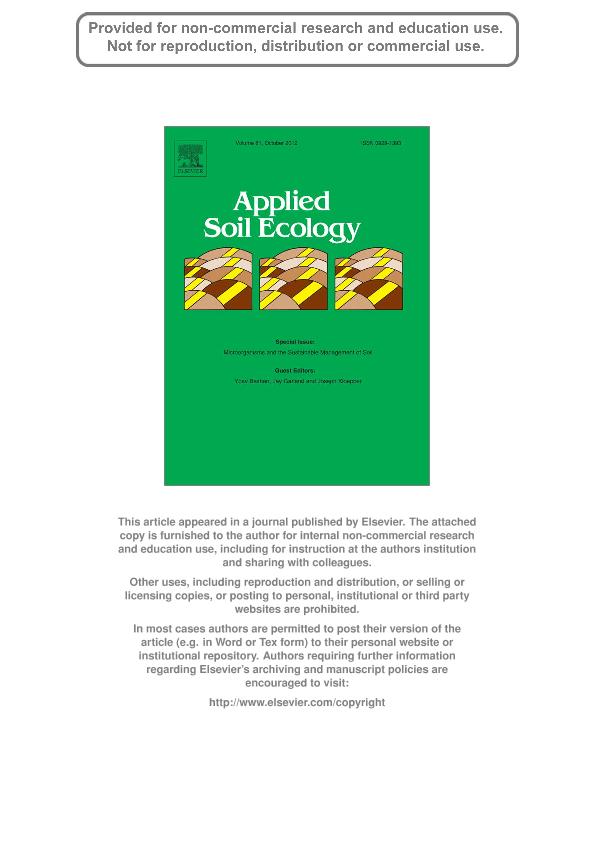Mostrar el registro sencillo del ítem
dc.contributor.author
Guerrero Molina, María Fernanda

dc.contributor.author
Winik, Beatriz Clara

dc.contributor.author
Pedraza, Raúl Osvaldo

dc.date.available
2023-04-27T12:07:57Z
dc.date.issued
2012-06
dc.identifier.citation
Guerrero Molina, María Fernanda; Winik, Beatriz Clara; Pedraza, Raúl Osvaldo; More than rhizosphere colonization of strawberry plants by Azospirillum brasilense; Elsevier Science; Applied Soil Ecology; 61; 6-2012; 205-212
dc.identifier.issn
0929-1393
dc.identifier.uri
http://hdl.handle.net/11336/195604
dc.description.abstract
Azospirillum brasilense is a plant growth promoting bacteria (PGPB), capable of improving growth and yield of important crops including strawberry (Fragaria ananassa, Duch.). Considering that for commercial purposes strawberry plants are asexually reproduced by planting stolons into the soil, the aim of this work was to evaluate Azospirillum root association and further colonization through stolons from bacterial inoculated strawberry mother-plants to new born daughter-plants. For that, three commercial cultivars of strawberry ('Camarosa', 'Milsei' and 'Selva') were root inoculated with two strains of A. brasilense: REC3 and PEC5. Scanning and transmission electron microscopy observations showed clear bacterial attachment to the root surface and colonization of root and stolon inner tissues. The diazotrophic bacteria were re-isolated from inoculated mother-plants, non-inoculated daughters and stolons using N-free NFb semisolid medium. In all cases, the MPN from root samples was higher than from stolons. The bacterial nifD gene, essential in the biological N 2-fixing process, was PCR-amplified from DNA of roots and stolons proving the occurrence of diazotrophs within these tissues. To confirm that these bacteria corresponded to the inoculated PGPB, the 16S rDNA gene of re-isolates was subjected to amplified rDNA restriction analysis (ARDRA) and to automated DNA sequencing, revealing that they belong to Azospirillum brasilense. This confirms effective rhizosphere colonization of strawberry mother-plants and also the colonization of A. brasilense to new daughter-plants via stolons. This is the first report about A. brasilense colonization from one strawberry plant to another one by colonizing inner tissues of roots and stolons. This means that a single inoculation with selected PGPB would allow the growers to have numerous plant generations at nursery already inoculated and with better conditions to be planted at field, contributing to a sustainable agricultural practice.
dc.format
application/pdf
dc.language.iso
eng
dc.publisher
Elsevier Science

dc.rights
info:eu-repo/semantics/openAccess
dc.rights.uri
https://creativecommons.org/licenses/by-nc-sa/2.5/ar/
dc.subject
AZOSPIRILLUM BRASILENSE
dc.subject
ELECTRON MICROSCOPY
dc.subject
FRAGARIA ANANASSA
dc.subject
NIFD
dc.subject
PGPB
dc.subject
STOLON
dc.subject.classification
Agronomía, reproducción y protección de plantas

dc.subject.classification
Agricultura, Silvicultura y Pesca

dc.subject.classification
CIENCIAS AGRÍCOLAS

dc.title
More than rhizosphere colonization of strawberry plants by Azospirillum brasilense
dc.type
info:eu-repo/semantics/article
dc.type
info:ar-repo/semantics/artículo
dc.type
info:eu-repo/semantics/publishedVersion
dc.date.updated
2023-04-19T17:24:59Z
dc.journal.volume
61
dc.journal.pagination
205-212
dc.journal.pais
Países Bajos

dc.journal.ciudad
Amsterdam
dc.description.fil
Fil: Guerrero Molina, María Fernanda. Universidad Nacional de Tucumán. Facultad de Agronomía y Zootecnia; Argentina. Consejo Nacional de Investigaciones Científicas y Técnicas; Argentina
dc.description.fil
Fil: Winik, Beatriz Clara. Consejo Nacional de Investigaciones Científicas y Técnicas. Centro Científico Tecnológico Conicet - Tucumán. Instituto Superior de Investigaciones Biológicas. Universidad Nacional de Tucumán. Instituto Superior de Investigaciones Biológicas; Argentina
dc.description.fil
Fil: Pedraza, Raúl Osvaldo. Universidad Nacional de Tucumán. Facultad de Agronomía y Zootecnia; Argentina
dc.journal.title
Applied Soil Ecology

dc.relation.alternativeid
info:eu-repo/semantics/altIdentifier/doi/http://dx.doi.org/10.1016/j.apsoil.2011.10.011
dc.relation.alternativeid
info:eu-repo/semantics/altIdentifier/url/https://www.sciencedirect.com/science/article/pii/S0929139311002307
Archivos asociados
